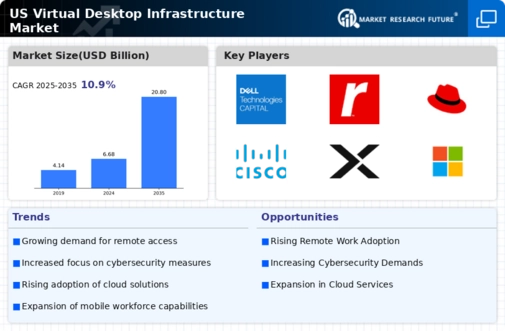The virtual desktop-infrastructure market is characterized by a dynamic competitive landscape, driven by the increasing demand for remote work solutions and the need for enhanced data security. Major players such as VMware (US), Citrix Systems (US), and Microsoft (US) are at the forefront, each adopting distinct strategies to solidify their market positions. VMware (US) focuses on innovation through continuous product enhancements, while Citrix Systems (US) emphasizes partnerships to expand its service offerings. Microsoft (US) leverages its extensive cloud infrastructure to integrate virtual desktop solutions seamlessly with its existing services, thereby enhancing user experience and operational efficiency. Collectively, these strategies contribute to a competitive environment that is both collaborative and competitive, as companies seek to differentiate themselves through technological advancements and customer-centric solutions.
Key business tactics within this market include localizing services to meet regional demands and optimizing supply chains to ensure reliability and efficiency. The competitive structure appears moderately fragmented, with several key players holding substantial market shares. This fragmentation allows for a diverse range of offerings, catering to various customer needs, while the influence of major companies shapes market trends and customer expectations.
In October 2025, VMware (US) announced a strategic partnership with a leading cybersecurity firm to enhance the security features of its virtual desktop solutions. This move is significant as it addresses growing concerns regarding data breaches and cyber threats, positioning VMware (US) as a leader in secure virtual desktop offerings. By integrating advanced security protocols, the company aims to attract enterprises that prioritize data protection, thereby expanding its customer base.
In September 2025, Citrix Systems (US) launched a new initiative aimed at improving user experience through AI-driven analytics. This initiative is crucial as it allows organizations to gain insights into user behavior, enabling them to optimize their virtual desktop environments. By harnessing AI, Citrix Systems (US) not only enhances its product offerings but also strengthens its competitive edge in a market increasingly focused on user-centric solutions.
In August 2025, Microsoft (US) unveiled a new version of its virtual desktop service, incorporating advanced machine learning capabilities to streamline resource allocation. This development is indicative of the company's commitment to innovation and reflects a broader trend towards integrating AI technologies into virtual desktop solutions. By enhancing performance and efficiency, Microsoft (US) is likely to attract a wider range of customers, reinforcing its position in the market.
As of November 2025, current competitive trends are heavily influenced by digitalization, sustainability, and the integration of AI technologies. Strategic alliances are becoming increasingly important, as companies recognize the value of collaboration in enhancing their service offerings. Looking ahead, competitive differentiation is expected to evolve, shifting from price-based competition to a focus on innovation, technological advancements, and supply chain reliability. This transition suggests that companies that prioritize these aspects will likely emerge as leaders in the virtual desktop-infrastructure market.





















Leave a Comment